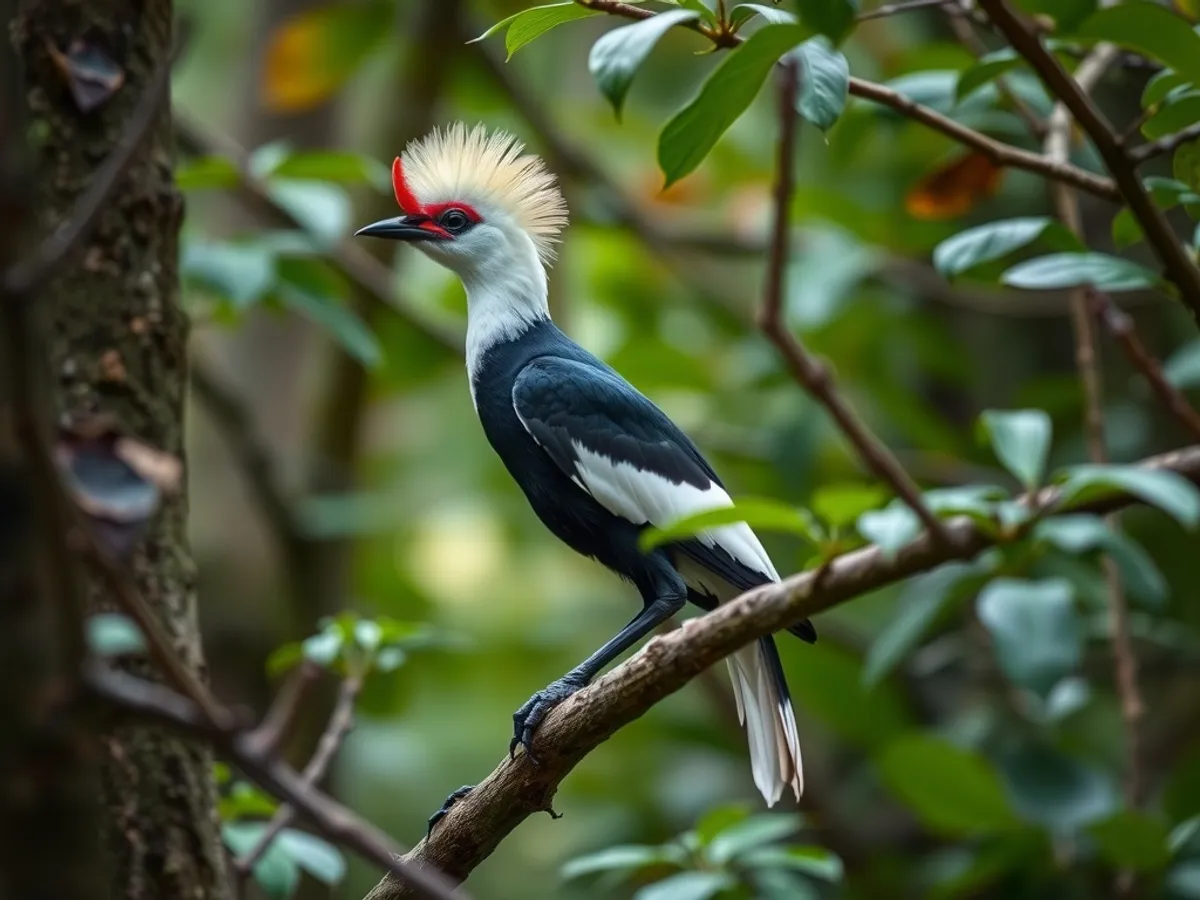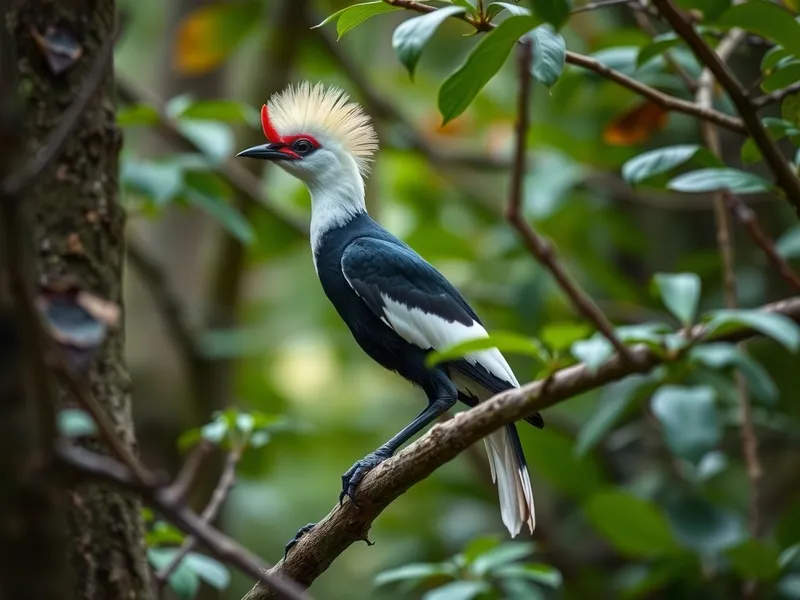
White-cheeked Turaco
Tauraco leucotis

Meet the White-cheeked Turaco
The White-cheeked Turaco is a striking, medium-sized bird renowned for its vivid green body, deep blue tail and wings, and bold white patches on its cheeks. Native to the montane forests of East Africa, especially Ethiopia and Eritrea, it is an agile climber and jumper among tree branches. Its crimson primary flight feathers, visible only when it flies, add to its spectacular appearance. The White-cheeked Turaco is known for its loud, barking call and plays a vital role in seed dispersal within its habitat.
Classification
Bird
Habitat
Montane forests
Diet
Herbivore
Lifespan
5-9 years
Conservation
Least Concern
Weight
200-315 g
📖Fascinating Facts
Forest Dweller
This species thrives in dense montane forests and woodland edges, spending most of its life in the tree canopy.
True Green
The green color in their feathers comes from a rare pigment, turacoverdin, making them one of the few birds with true green pigment.
Fruit Lover
Their diet consists mainly of fruits, but they also eat leaves, flowers, and occasionally small invertebrates.
📋Detailed Description
The White-cheeked Turaco (Menelikornis leucotis) is a visually striking bird, measuring approximately 43 cm (17 in) in total length, with a tail of about 19 cm (7.5 in) and weighing between 200–315 g (7.1–11.1 oz). Its plumage is predominantly a vibrant green, which is due to unique turacoverdin pigments, with a deep blue hue on the wings and tail. The most distinctive feature is the bold white patch on each cheek, contrasting sharply with the surrounding green. The bird's crown and nape are tinged with a purplish-blue, and its eyes are encircled by a bright red orbital ring. When in flight, the White-cheeked Turaco reveals crimson primary flight feathers, a trait shared with other turacos, caused by the presence of turacin pigment. The bill is short, strong, and red, adapted for fruit consumption, while the legs and feet are robust, with semi-zygodactylous toes that allow for agile climbing and leaping among branches. This species exhibits a strong, bounding flight but prefers to move through the canopy by running and hopping. Its vocalizations are loud, resonant, and barking, serving both territorial and social functions. The White-cheeked Turaco is highly social, often seen in small family groups or loose flocks, and plays a crucial ecological role as a seed disperser in montane forests.
💡 Did you know?
Unlike parrots, turacos have semi-zygodactylous feet, allowing them to run and hop adeptly along branches.
🔬Research & Sources
Wikipedia Summary
The white-cheeked turaco is a species of bird in the family Musophagidae. It is found in Eritrea, Ethiopia, and South Sudan. A mid-sized species, it measures about 43 cm (17 in) in length, including a tail of 19 cm (7.5 in), and weighs about 200–315 g (7.1–11.1 oz). This species is the most commonly raised turaco in captive conditions.
Last Modified: 4/23/2025
🎭Behavior & Social Structure
White-cheeked Turacos are diurnal and highly arboreal, rarely descending to the ground except to drink or bathe. They are agile climbers, using their strong feet and flexible toes to grip branches, and are capable of impressive leaps between trees. Their diet is primarily frugivorous, consisting mainly of fruits, berries, and figs, but they also consume leaves, flowers, and occasionally small invertebrates. Feeding is typically a social activity, with groups foraging together and communicating through a series of calls and visual displays. Social structure is centered around family groups, often with cooperative behaviors such as mutual preening and alarm calling. Turacos are territorial during the breeding season, with pairs or family groups defending feeding and nesting sites. Their daily routine includes periods of feeding in the early morning and late afternoon, interspersed with resting and social interactions in the canopy.
👶Reproduction & Life Cycle
The breeding season of the White-cheeked Turaco generally coincides with the onset of the rainy season, varying locally but often between March and June. Courtship involves mutual feeding, chasing, and display of plumage. Pairs are monogamous, and both parents participate in nest building, which consists of a flimsy platform of twigs placed 3–10 meters above ground in dense foliage. The female typically lays 2 eggs, which are incubated by both parents for about 21–24 days. After hatching, chicks are altricial and remain in the nest for 4–5 weeks. Both parents feed the chicks through regurgitation. Juveniles are capable of climbing out of the nest before they can fly, using their well-developed claws and wing claws for grip. Fledging occurs around 4–6 weeks after hatching, but young may remain with the family group for several months.
🛡️Adaptations & Survival
White-cheeked Turacos possess several unique adaptations for an arboreal lifestyle. Their semi-zygodactylous feet (the fourth toe can rotate backward) enhance their ability to grasp branches and climb. The presence of turacoverdin and turacin pigments in their feathers is unique among birds, providing both camouflage in foliage and potential antioxidant benefits. Their strong, curved bill is specialized for manipulating and consuming a variety of fruits. The species’ loud calls are adapted for communication in dense forest environments, and their cryptic coloration helps avoid predation. Juveniles are born with wing claws, aiding in climbing before they are capable of flight, an adaptation to the forest canopy. Social behaviors such as group foraging and cooperative vigilance increase survival in predator-rich habitats.
📚Research Sources
🎨Cultural Significance
In Ethiopia and Eritrea, the White-cheeked Turaco is a familiar bird, often featured in local folklore and admired for its striking appearance. Its feathers, especially the crimson flight feathers, have been historically used in traditional adornments and ceremonial attire. The bird is sometimes seen as a symbol of the lush highland forests and is appreciated for its role in maintaining the health of these ecosystems. In aviculture, it is the most commonly kept turaco species, valued for its beauty and relatively adaptable nature in captivity.
🔬Recent Research & Discoveries
Recent research on the White-cheeked Turaco has focused on its unique feather pigments, particularly turacoverdin and turacin, which are rare among birds and have potential implications for understanding avian coloration and antioxidant mechanisms. Studies have also examined the species’ role in seed dispersal and forest regeneration, highlighting its importance in ecosystem functioning. Genetic analyses have clarified its phylogenetic relationships within the Musophagidae, supporting its placement in the genus Menelikornis. Ongoing field studies are investigating the effects of habitat fragmentation on movement patterns and genetic diversity. The species is also a model for studying cooperative breeding and social behavior in turacos.
🎥Wildlife Videos

White-Cheeked Turaco | Bird Song | Aviary Birds
White-cheeked turaco bird singing in outdoor bird aviary. #birds #aviary #softbills #burung #birdsong #birdwatching ...
Tropical Aviary Birds - Torben Dehlholm

White Cheeked Turaco native to the forests of Ethiopia and Eritrea
Nature lover

White cheeked Turaco || Sherwin Buluran
watchfirstLikeSubscribecomment I first saw a Turaco when I was travelling fro Addis. It even looked towards me while flying.
Sherwin BTV

White Cheeked Turaco | Aviary Birds
Tropical Aviary Birds - Torben Dehlholm

White cheeked turaco bird | Aviary birds #birds #bird #animals #nature
Tropical Aviary Birds - Torben Dehlholm

The Haughty Charm of the White-cheeked Turaco: A Stunning Avian Beauty #birds
Wildlife Wonders
🌍Habitat Information
The White-cheeked Turaco typically inhabits Montane forests environments. White-cheeked Turacos have adapted to their environments with specialized features and behaviors.
Primary Habitat:
Montane forests
More detailed habitat information will be available soon.
🛡️Conservation Status
The White-cheeked Turaco is currently classified as Least Concern. Conservation efforts are crucial for preserving this species for future generations.
Common Threats:
- 🏠Habitat loss and fragmentation
- 🌡️Climate change impacts
- 🎯Hunting and poaching
- 🏭Human-wildlife conflict
⚠️Threats & Conservation Challenges
Currently assessed as Least Concern by the IUCN, the White-cheeked Turaco maintains stable populations across its range. However, localized threats include habitat loss due to deforestation for agriculture, logging, and human settlement expansion, particularly in Ethiopia's highland forests. The species is sometimes captured for the pet trade, as it is popular in aviculture, but this has not significantly impacted wild populations. Climate change poses a potential long-term threat by altering montane forest habitats. Conservation challenges include habitat fragmentation and the need for effective protected area management. Ongoing monitoring is recommended to detect any future population declines.
🔬Scientific Classification
Scientific Name
Tauraco leucotis
Classification Hierarchy
🔍 About Taxonomic Classification
Taxonomic classification is a hierarchical system used by scientists to classify and organize living organisms based on shared characteristics and evolutionary relationships.
The system moves from broad categories (Kingdom) to increasingly specific ones, with each animal's scientific name typically consisting of its Genus and species.
📝Community Notes
Share your observations and insights about the White-cheeked Turaco with our community of wildlife enthusiasts.
Join Our Community
Sign in to share your observations and connect with fellow wildlife enthusiasts.
Sign In to ContributeNo community notes yet
Be the first to share your observations about the White-cheeked Turaco!
Explore White-cheeked Turaco
Select a tab above to learn more about this amazing animal.
📸Photo Gallery
No photos available for this animal yet.
🌟Discover More Wildlife
Continue your journey of discovery with more fascinating animals from our database
